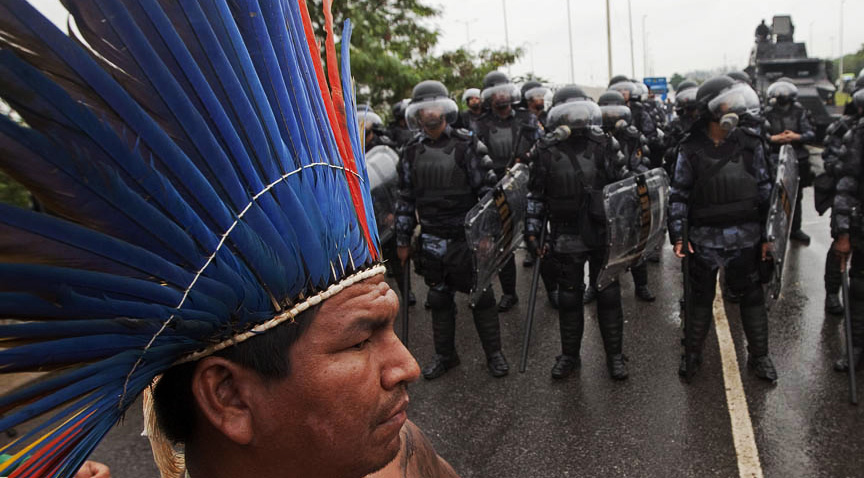U.S. Government Bans Native American Tribe from Protesting on Their Own Land – Send in Police to Remove Protesters
ACTIVISM, 29 Aug 2016
Jafari Tishomingo – Counter Current News
21 Aug 2016 – A North Dakota federal court has prohibited indigenous tribes from protesting the Bakken pipeline on their own reservations.
Dakota Access, a developer of the pipeline, filed the report citing “Worker and law enforcement safety was at risk”.
This reaction originates from the non-violent protest by the Sanding Rock, Rose Bud and lower Brule Sioux. Dave Archambault II, chairman of the Standing Rock Sioux Tribe said, “as we have said from the beginning, demonstrations regarding Dakota Access must be peaceful.”
Even though there had been no report of violent confrontation with police or otherwise, removing the protest encampments and demonstrators may proceed.
The Bakken pipeline is the less popular version of the Keystone XL pipeline. The Bakken pipeline is 1,134-mile long underground oil pipeline project for crude oil from the Bakken oil fields in Northwest North Dakota, through South Dakota, Iowa and end in Patoka, Illinois.
The Bakken project runs through Native American sacred sites, water sources, such as the Mississippi and Missouri rivers. When money is to be made like $3.8-billion and 570,000 barrels of sweet crude oil every day to feed America’s oil habit, we don’t let scared sites or ecosystems get in the way.
Take for example when trespassing settlers found gold in Pahá Sápa or the black hills in 1874.
The black hills where Dakota land by treaty with the United States,once gold was found in Pahá Sápa, the US rescinded the treaty. After the US broke the treaty the gave the Dakota 6 smaller land parcels.
To the Dakota, Pahá Sápa was sacred and no 6 parcels could replace it. When it comes to profit there is nothing sacred enough.
We also have to take into account the environmental destruction the Bakken pipeline will spread across over 1,100 miles? The process used by Dakota Access is Hydraulic fracturing from North Dakota’s oil-rich Bakken Formation. Hydraulic fracturing or “Fracking” has many environmental hazards that outweigh the economic benefits.
Increased seismic activity is felt along dormant or long quiet fault lines. One of the big issues with fracking has the potential to contaminate ground and surface water. Here is a video with some lighting their water on fire with fracking going on nearby.
httpv://www.youtube.com/watch?v=4LBjSXWQRV8
Let’s also remember Native American tribes were not given the right to free speech, press, and assembly until the Indian Civil Rights Act (ICRA) in 1968.
Even now those rights are selective and arbitrarily removed at the whim of the state whenever it best profits their interests.
Go to Original – countercurrentnews.com
DISCLAIMER: The statements, views and opinions expressed in pieces republished here are solely those of the authors and do not necessarily represent those of TMS. In accordance with title 17 U.S.C. section 107, this material is distributed without profit to those who have expressed a prior interest in receiving the included information for research and educational purposes. TMS has no affiliation whatsoever with the originator of this article nor is TMS endorsed or sponsored by the originator. “GO TO ORIGINAL” links are provided as a convenience to our readers and allow for verification of authenticity. However, as originating pages are often updated by their originating host sites, the versions posted may not match the versions our readers view when clicking the “GO TO ORIGINAL” links. This site contains copyrighted material the use of which has not always been specifically authorized by the copyright owner. We are making such material available in our efforts to advance understanding of environmental, political, human rights, economic, democracy, scientific, and social justice issues, etc. We believe this constitutes a ‘fair use’ of any such copyrighted material as provided for in section 107 of the US Copyright Law. In accordance with Title 17 U.S.C. Section 107, the material on this site is distributed without profit to those who have expressed a prior interest in receiving the included information for research and educational purposes. For more information go to: http://www.law.cornell.edu/uscode/17/107.shtml. If you wish to use copyrighted material from this site for purposes of your own that go beyond ‘fair use’, you must obtain permission from the copyright owner.
